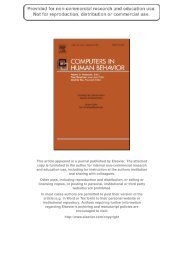Varnhagen.pdf
You also want an ePaper? Increase the reach of your titles
YUMPU automatically turns print PDFs into web optimized ePapers that Google loves.
720 C. K. <strong>Varnhagen</strong> et al.<br />
Introduction<br />
Electronic technologies offer many different opportunities for written communication.<br />
Increasing numbers of people are communicating with each other through<br />
various technologies such as phone-based text messaging, Internet-based instant<br />
messaging, synchronous chat, asynchronous discussion forums, and e-mail. Many of<br />
these communications are interactive, much like a conversation but conducted at a<br />
distance (often both in time and space) and in written form. Possibly to speed up the<br />
communicative exchange (Werry, 1996), communicators have developed short cuts<br />
for expressing words, phrases, and emotions as well as textual and graphical<br />
pragmatic devices. These short cuts and pragmatic devices have become so ubiquitous<br />
in electronic communication that they are now being collected in dictionaries (e.g.,<br />
Jansen, 2003; Shoeman & Shoeman, 2007; http://www.netlingo.com; http://www.<br />
urbandictionary.com).<br />
Electronic communication is very popular among adolescents; according to<br />
ongoing surveys from the Pew Internet and Family Life project, the vast majority of<br />
adolescents in the United States engage in various forms of electronic communication<br />
on a daily basis, and instant messaging is one of the most popular forms of<br />
electronic communication for this age group (Lenhart, Madden, & Hitlin, 2005;<br />
Lenhart, Madden, Macgill, & Smith, 2007; Lenhart, Rainie, & Lewis, 2001). Instant<br />
messaging is a synchronous form of communication between two or more people,<br />
(a) using a specialized Internet application, such as AOL Instant Messenger (AIM),<br />
Windows Live Messenger (MSN), or ICQ, (b) within an online game or virtual<br />
world, such as the World of Warcraft Instant Messenger and Second Life chat, or (c)<br />
through a social networking site, such as Facebook or MySpace Instant Messaging.<br />
As shown in Fig. 1, these instant messaging applications typically open a small<br />
window for communication. Each participant in the communication is identified by<br />
his or her user name and messages are displayed in the order in which they are<br />
posted. The format of these typed messages graphically represents turn taking in a<br />
conversation (Grinter, Palen, & Eldridge, 2006; Merchant, 2001).<br />
Typing is much slower and more error prone than is speaking (Herring, 1999,<br />
2003); possibly to compensate for these issues, people communicating though<br />
instant messaging have developed short cuts to typing full words, such as l8r for<br />
later, or acronyms for common phrases, such as brb for be right back (Werry,<br />
1996). Although emotion is often assumed in online messages (Kruger, Epley,<br />
Parker, & Ng, 2005), users may have developed text and graphic pragmatic devices<br />
to support or enhance communication functions (Lewis & Fabos, 2005). These text<br />
and pragmatic devices include text or graphic ‘‘smileys’’ or emoticons to convey an<br />
expressive function of language, or abbreviations such as YW for you’re welcome to<br />
express a phatic function (Jakobson, 1960).<br />
While the media and some researchers, teachers, and parents (e.g., http://www.<br />
oxfordlearning.com/letstalk/texting-vs-writing-the-problem-with-instant-messag/;<br />
Lee, 2002) may interpret the technically incorrect language and spelling ‘‘errors’’ in<br />
instant messaging conversations as detrimental and incorrect, some researchers<br />
(e.g., Lewis & Fabos, 2005; Merchant, 2001; Spatafora, 2008; Tagliamonte &<br />
Denis, 2006) suggested that this phenomenon simply represents contemporary<br />
123
















